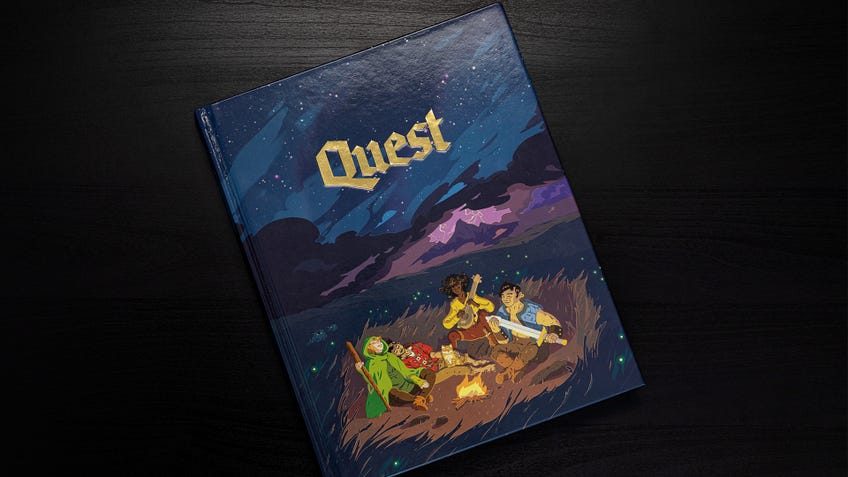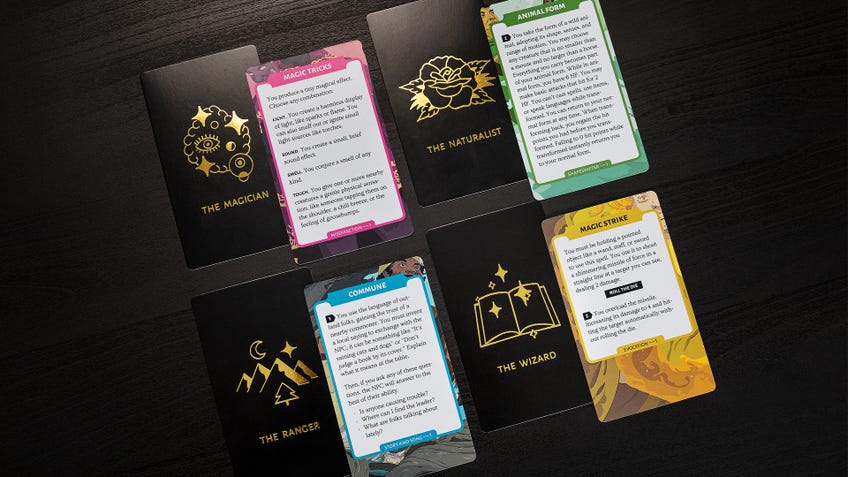“I won’t rest until Instagram influencers are posing with the game book”: Quest creator TC Sottek on making the world’s friendliest RPG
How podcasts, social media and Adobe InDesign inspired one of the freshest roleplaying games in years.
Quest was created with a single purpose in mind: to get as many different people as possible into tabletop roleplaying.
According to designer TC Sottek, the tabletop RPG was originally going to be a podcast which Sottek was inspired to make “after listening to hundreds of hours of real play stuff in various podcasts”.
Sottek felt like there wasn’t really a tabletop roleplaying game out there that allowed people to spread their creative wings. He particularly noted how often the GMs on podcasts such as The Adventure Zone and Sneak Attack would simply rewrite or ignore the rules in favour of loose storytelling or character development.
The storytelling aspects of Dungeons & Dragons had a huge appeal to Sottek, having started playing Fifth Edition around five years ago and ended up hooked on the potential for world-building outside of traditional roleplaying.
“I really went wild - I started building my own world for our games and ordering wax-sealing stamps on Etsy for handmade invitations,” he says.
I stayed up all night writing the first draft of Quest.
After seeing how listeners lamented about the difficulty of recreating the kind of character interactions and stories they’d heard on the podcasts they loved, Sottek says he wanted to craft a roleplaying game that better allowed for these memorable moments.
“The goal early on was to create a system that helped people have an epic fantasy experience like the ones they were hearing on popular shows,” he says. “So, I stayed up all night writing the first draft of Quest.”
The key was to strip away a lot of the classic “school textbook” elements that Sottek felt many tabletop RPGs suffered from, with rulebooks explaining ridiculous concepts like “angry jelly creatures” in a self-serious manner; “If you wouldn’t say it to someone in a conversation, why would you put it on a page?”

In response, Sottek began by writing Quest in a deliberately relaxed style that spoke to the reader in a conversational tone - the book greets players with “Welcome, friend. This is a special place: a retreat from your worries and obligations.” One way the designer achieved this friendly tone was to type directly into a book layout in Adobe InDesign, which showed how the text would fit in amongst the rest of the visual elements and the amount of space it would take up on the page.
“There literally wasn’t room to write bloated, bureaucratic prose,” he explains.
Page structure was a fundamental element to Quest’s design philosophy, with Sottek deliberately veering away from the intimidating and chunky layouts found in the otherwise beloved rulebooks for Dungeons & Dragons 5E. Sottek comments on how the art direction of many tabletop RPG rulebooks look like they’re “targeted toward young boys instead of a more inclusive audience” - something the designer was determined to avoid.
The illustrators behind Quest - Grim Wilkins, Marianna Learmonth and Kevin Sottek - may not have been Sottek’s original choice for the roleplaying game, replacing original artist Celia Lowenthal after the game’s successful Kickstarter in 2018, but it quickly became apparent that they were the right choice. As lead illustrator, Wilkins enhanced the text with beautiful artwork that reflected the “welcoming tone of the writing and game design”, Sottek says, with tattoo artists Learmonth and Kevin Sottek providing images for the treasure catalogue and character roles.
If you wouldn’t say it to someone in a conversation, why would you put it on a page?
Besides making Quest feel more inclusive to newer players, Sottek wanted the rulebook to reflect how the essence of roleplaying is built on conversation - whether it’s characters speaking with each other or the players discussing with the GM. Having the rulebook read like a conversation was designed to intentionally ease the players and GM into the act of roleplaying before they even sat down to play the game.
“I’ve watched complete beginners read through the rulebook in a breeze and tell me they didn’t expect it to seem so easy,” Sottek says.
Sottek believes that the look and feel of a roleplaying rulebook can make it seem significantly more attractive to a larger audience, having been disappointed in the subpar way other publishers tended to approach the appearance of their products. The hardback version of Quest was designed from the outset to look and feel incredibly stylish in comparison to many of its competitors.
“We wanted to make a fantasy storytelling game that people would be excited to show off on Instagram,” the designer says. “I won’t rest until Instagram influencers are posing with the game book.”
Sottek suggests the key way tabletop RPG creators can make their rulebooks feel more approachable is by encouraging better social behaviour in their readers. Tabletop roleplaying games can become very personal experiences, especially when players feel a strong connection to their characters or the themes in the story, so Sottek feels that being careful to be kind should be an essential rule of any TRPG.
“I think [social rules] ought to be the norm in every tabletop roleplaying game,” he says. “If your rules don’t address it at all, you’ve neglected your players.”
There is a specific section of the Quest rulebook that covers how players and The Guide - Quest’s equivalent of a game master - should act towards each other, from respecting boundaries to asking for consent. There is even a stop sign card in the official game deck that players can use whenever they feel uncomfortable with current events.
Communication played an important part in Quest’s development, and Sottek believes it will continue to influence the way that people play the game long into the future.
“Guides should constantly be looking to the players for inspiration,” he advises.
Aside from the myriad of books, films, television shows and other forms of media The Guide may draw from for storytelling prompts, it’s ultimately the interaction between characters that drives the narrative in Quest - one reason why character creation in the game requires more creative input than number crunching.

As for the future of Quest, Sottek reveals he’s currently working on an adventure format for the roleplaying game, “which is a flexible system that will allow long-term groups to continue a shared story, even if a different combination of players meet each time”. The designer also mentions plans to give Quest “more of an official setting” at some point.
For now, he encourages players take what they want from the rulebook’s cryptic hints at world-building, emphasising the “optional” nature of elements like magic items and the part they can play in people’s stories - adding how much he loves the implications behind an Albatross Pendant that can dispatch the latest news stories. (By day, Sottek is executive editor for technology outlet The Verge.)
Quest has the potential to grow into the beginner’s RPG of choice, especially considering how easy to learn it is when compared to many of its contemporaries and how irresistibly charming the entire rulebook is to read. If Sottek continues to support his RPG with new supplements, there isn’t any reason that the growing world of Quest shouldn’t succeed in bringing droves of new roleplayers into the fold.


